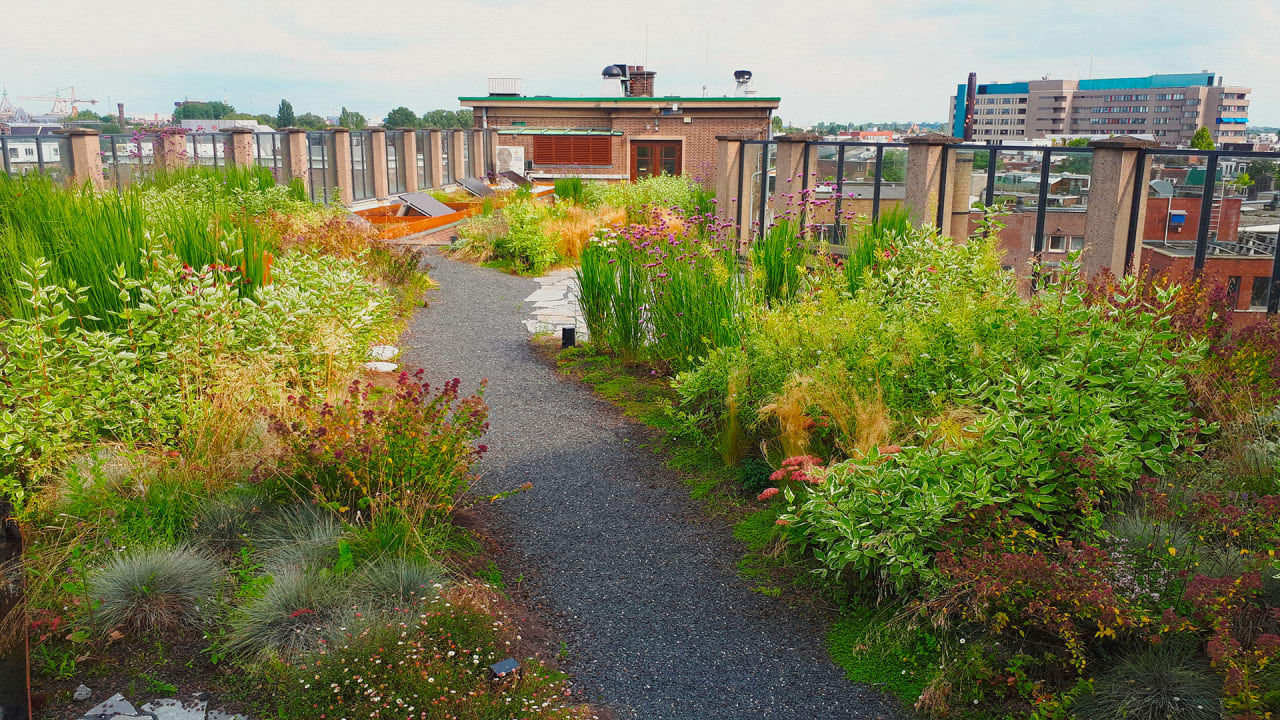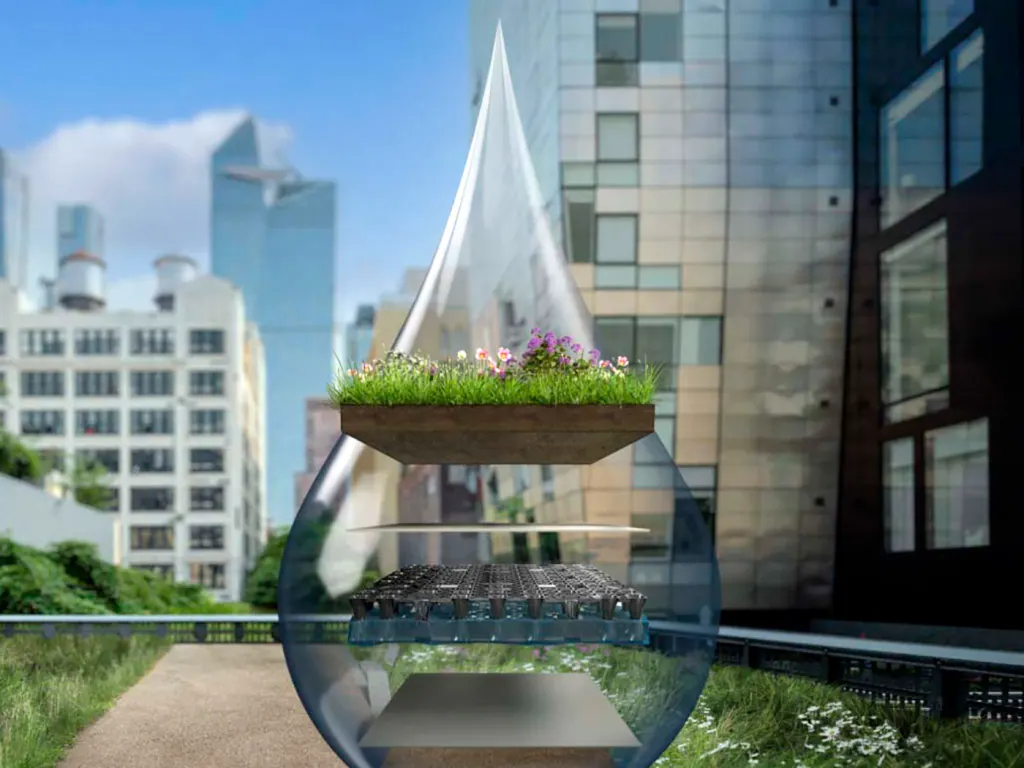Amsterdam’s gorgeous green roofs have hidden reservoirs to capture rainwater
If you walk up to the roof of a social-housing apartment building in Amsterdam, you’ll see a sprawling garden covered in plants. Hidden under the flowers and grass is an extra layer: a thin reservoir that can store rainwater in storms. Down the street, the same water-storing technology sits under another rooftop garden. It’s also installed on multiple other buildings in flood-prone Amsterdam neighborhoods. The city now has a network of “blue-green” roofs—designed to boost biodiversity, keep buildings cooler in heat waves, and help deal with increasingly frequent extreme rain. The city government in Amsterdam started looking for new ways to deal with rain more than a decade ago, after a storm in Copenhagen dump around six inches of rain in less than two hours, leading to severe flooding. Climate change is making heavy rain more likely, and the traditional sewer systems in most cities can’t keep up. Amsterdam’s government considered places to add new green space to help capture rain. But in a city that’s already densely built, there wasn’t much room for new parks. City leaders started asking a new question: “How can we make better use of the buildings that exist—and groups of buildings—to capture and store more rainwater?” says Brian Schmitt, an account manager in urban climate resilience design and engineering for Orbia, the company that makes the blue-green roof technology. How a blue-green roof works A typical green roof, with a thin layer of vegetation, can also store some water when it rains. But if it keeps raining, or in a heavy storm, the water washes off. A blue-green roof system includes a retention unit under the plants and soil. The system connects to weather forecasts. If rain is expected and the reservoir is already full, a valve can automatically open to slowly let water out in advance, making room for more. One study found that the technology can capture between 70% to 97% of the rain in that falls on a roof in an extreme storm. A basic green roof, by contrast, can only capture around 12% of the rain. “You are capturing more water and you can monitor how much you are storing at any time,” Schmitt says. By keeping rain on rooftops, it’s less likely that the sewer system will overflow and flood streets. Amsterdam’s water agency used Autodesk software to model the benefits in a particular neighborhood. While a single roof wouldn’t make a huge difference, the team found that if all the suitable roofs were converted, flooding could drop by 60%. Rain is a major challenge in the area. The first six months of 2024 were the wettest on record for the Netherlands. Over the next three decades, more than a quarter of properties in Amsterdam are at risk of severe flooding. As in other regions, weather whiplash is also a problem: heavy rain can quickly be followed by drought, or vice versa. The technology can also help by holding water when it isn’t raining, slowly wicking water up to the rooftop plants to keep them alive. The rooftop systems “become squeezable sponges: they retain water in periods of drought and heat, and squeeze and create storage with expected rainfall,” Kasper Spaan, a climate adaptation specialist at Waternet, Amsterdam’s water agency, wrote in a report about the city’s first tests of blue-green roofs. [Rendering: Courtesy of Orbia] In hot weather, water evaporates through the plants, helping cool the surrounding area. (If plants die, green roofs lose most of their cooling power, Schmitt says.) With the new blue-green roofs, if extra water has to be released before a storm, it flows down to the city’s sewer system. But the technology can also be connected to cisterns to provide water for landscaping on the ground, or even to help flush toilets inside the building. Scaling up In a pilot project called Resilio, completed in 2022, the government helped fund the installation of the tech on several social-housing apartment buildings. They focused on neighborhoods that were especially likely to flood, and on buildings with aging roofs that were already in need of replacement. In total, the project converted more than 100,000 square feet of rooftop space. The project cost €6 million (around $6.6 million), with an 80% grant from an EU urban innovation program. Now, “the number of retention roofs is growing significantly,” says Spaan. In 2021, the city passed a new ordinance that requires builders to include rainwater storage in all new buildings or large-scale renovations. Spaan estimates that around 80% of construction sites are relying on blue-green roofs to meet that requirement. [Photo: Courtesy of Orbia] The water storage tech can also be used without a garden. In one new development under construction with hundreds of housing units and a community school, the tech will be used on balcony gardens. But the water storage component of the tech will also be hidden under solar panels on the roof. The technology can also be used in ground-level cour

If you walk up to the roof of a social-housing apartment building in Amsterdam, you’ll see a sprawling garden covered in plants. Hidden under the flowers and grass is an extra layer: a thin reservoir that can store rainwater in storms.
Down the street, the same water-storing technology sits under another rooftop garden. It’s also installed on multiple other buildings in flood-prone Amsterdam neighborhoods. The city now has a network of “blue-green” roofs—designed to boost biodiversity, keep buildings cooler in heat waves, and help deal with increasingly frequent extreme rain.
The city government in Amsterdam started looking for new ways to deal with rain more than a decade ago, after a storm in Copenhagen dump around six inches of rain in less than two hours, leading to severe flooding. Climate change is making heavy rain more likely, and the traditional sewer systems in most cities can’t keep up. Amsterdam’s government considered places to add new green space to help capture rain. But in a city that’s already densely built, there wasn’t much room for new parks.
City leaders started asking a new question: “How can we make better use of the buildings that exist—and groups of buildings—to capture and store more rainwater?” says Brian Schmitt, an account manager in urban climate resilience design and engineering for Orbia, the company that makes the blue-green roof technology.
How a blue-green roof works
A typical green roof, with a thin layer of vegetation, can also store some water when it rains. But if it keeps raining, or in a heavy storm, the water washes off. A blue-green roof system includes a retention unit under the plants and soil. The system connects to weather forecasts. If rain is expected and the reservoir is already full, a valve can automatically open to slowly let water out in advance, making room for more.
One study found that the technology can capture between 70% to 97% of the rain in that falls on a roof in an extreme storm. A basic green roof, by contrast, can only capture around 12% of the rain. “You are capturing more water and you can monitor how much you are storing at any time,” Schmitt says. By keeping rain on rooftops, it’s less likely that the sewer system will overflow and flood streets. Amsterdam’s water agency used Autodesk software to model the benefits in a particular neighborhood. While a single roof wouldn’t make a huge difference, the team found that if all the suitable roofs were converted, flooding could drop by 60%.
Rain is a major challenge in the area. The first six months of 2024 were the wettest on record for the Netherlands. Over the next three decades, more than a quarter of properties in Amsterdam are at risk of severe flooding. As in other regions, weather whiplash is also a problem: heavy rain can quickly be followed by drought, or vice versa. The technology can also help by holding water when it isn’t raining, slowly wicking water up to the rooftop plants to keep them alive.
The rooftop systems “become squeezable sponges: they retain water in periods of drought and heat, and squeeze and create storage with expected rainfall,” Kasper Spaan, a climate adaptation specialist at Waternet, Amsterdam’s water agency, wrote in a report about the city’s first tests of blue-green roofs.

In hot weather, water evaporates through the plants, helping cool the surrounding area. (If plants die, green roofs lose most of their cooling power, Schmitt says.) With the new blue-green roofs, if extra water has to be released before a storm, it flows down to the city’s sewer system. But the technology can also be connected to cisterns to provide water for landscaping on the ground, or even to help flush toilets inside the building.
Scaling up
In a pilot project called Resilio, completed in 2022, the government helped fund the installation of the tech on several social-housing apartment buildings. They focused on neighborhoods that were especially likely to flood, and on buildings with aging roofs that were already in need of replacement. In total, the project converted more than 100,000 square feet of rooftop space. The project cost €6 million (around $6.6 million), with an 80% grant from an EU urban innovation program.
Now, “the number of retention roofs is growing significantly,” says Spaan. In 2021, the city passed a new ordinance that requires builders to include rainwater storage in all new buildings or large-scale renovations. Spaan estimates that around 80% of construction sites are relying on blue-green roofs to meet that requirement.

The water storage tech can also be used without a garden. In one new development under construction with hundreds of housing units and a community school, the tech will be used on balcony gardens. But the water storage component of the tech will also be hidden under solar panels on the roof. The technology can also be used in ground-level courtyards or under permeable pavement.
“Think of building a layer cake,” says Schmitt. On a taller building, the highest roof might have solar panels with the technology underneath it, and no plants. Courtyards on lower floors, which are accessible and visible from windows, could have the tech under gardens. At ground level, the tech could also be used to help store even more water.
Of course, all of this adds expense to buildings—and it’s not likely to grow as quickly in cities that don’t give developers a similar requirement for water storage. (Old buildings are another challenge and can’t always take the extra weight.) Still, Orbia is now working on dozens of projects around the world, from London to New York City.





















